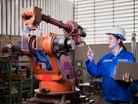Robotics Reshaping Manufacturing and the Future of Work

Industrial robotics have become an increasingly common sight in manufacturing facilities, warehouses, and assembly lines around the world. These automated, programmable machines are transforming industrial processes, boosting productivity and reshaping the nature of work in a wide range of sectors.
The use of industrial robots has grown rapidly in recent years. According to Statista figures, the global industrial robots market is worth a staggering US$55bn, with more than 2.7 million industrial robots operating in factories around the world. China remains the world's largest market for industrial robots, accounting for around 52% of global robot installations, but robot adoption is also surging in other major economies, including the United States, Germany, Japan and South Korea.
Automotive manufacturing has been a key driver of the industrial robotics trend, with automakers relying extensively on robots for tasks like welding, painting, and assembly on the production line. But robotics is also making major inroads in other industries, from electronics and semiconductor fabrication to food processing, logistics and even some construction applications.
Warehousing and logistics in particular have seen an explosion of robotic systems in recent years. Robots are being deployed for inventory management, order picking, palletising, and automating repetitive tasks across the supply chain. E-commerce giants like Amazon have been at the forefront of this trend, investing heavily in robotic fulfilment centres to keep up with surging online shopping demand.
The company said last year that it has started testing human-like robot solutions at its robotics research and development site with the goal of performing repetitive tasks. Following previous explorations into robotics, Amazon last year started testing Digit, a two-legged robot that can grasp and lift items, which is being developed as a result of its partnership with Agility Robotics, first intended to be used to shift empty tote boxes, a ‘highly repetitive’ process.
Amazon and Agility Robotics: Warehouse robotics
With more than 750,000 robots already deployed, Amazon has already started testing human-like robot solutions at its robotics research and development site to perform repetitive tasks and work collaboratively with employees.
“Digit can move, grasp, and handle items in spaces and corners of warehouses in novel ways,” Amazon said in a statement. “Its size and shape are well suited for buildings that are designed for humans.
“We believe there is a big opportunity to scale a mobile manipulator solution, such as Digit, which can work collaboratively with employees.”
One of Agility Robotics’ humanoid robots, Digit, is designed to move in a more dynamic fashion than regular robots. It has two legs and is covered in sensors, allowing it to navigate complex environments, with its size and shape well-suited for logistics work.
“We built Digit to solve difficult problems in today’s workforce like injuries, burnout, high turnover and unfillable labour gaps, with the ultimate vision of enabling humans to be more human,” said Damion Shelton, co-founder and CEO of Agility Robotics. “When you’re building new technology to make society better, the most important milestone is when you’re able to mass produce that technology at a scale where it can have a real, widespread impact.”
The growing adoption of industrial robots
The growing adoption of industrial robots is driven by a range of factors. Advances in sensors, computing power and AI are making robots more capable, flexible, and user-friendly. Labour shortages and rising wage costs in many countries are also spurring companies to automate more tasks, while the COVID-19 pandemic highlighted the resilience and efficiency benefits of robotic systems, accelerating automation plans in numerous industries.
Recent advances in deep learning algorithms have also allowed robots to perform more complex tasks, with increasing numbers of industry leaders now predicting that the robotics industry is set to dramatically accelerate.
“We have many partners developing applications using AI to allow our robots to perform more complex and diverse functions,” comments Anders Billesø Beck, Vice President of Strategy and Innovation at Universal Robots. “For example, AI allows robots to have human-like perception, handle variation, move parts precisely, adapt to changing environments, and learn from their own experience.
“With time, these capabilities will lead to unprecedented flexibility, quality and reliability in manufacturing.”
Robotics and the workforce
The rise of industrial robotics also raises important questions about the future of work. As robots take on an expanding range of manual and cognitive tasks, there are concerns about job displacement, particularly for low-skill workers. Governments and businesses will need to grapple with the social and economic implications, including the need for retraining and reskilling programs.
But proponents argue that industrial robotics will also create new types of skilled jobs, from robot programming and maintenance to data analysis and process optimisation. They say robots can free up human workers to focus on higher-value, more rewarding tasks. And by boosting productivity and competitiveness, robotics could help secure a country's manufacturing base and create new economic opportunities.
The general consensus is that robots will work with, rather than against, humans. However, the need for robust training and upskilling programmes for human employees is still a must for businesses.
As robots become increasingly more developed, businesses must have a clear AI strategy in place. Likewise, all employees must fully understand the strategies and corporate goals in place in order to work better alongside robots.
According to Chris Roberts, Head of Industrial Robotics at Cambridge Consultants, the landscape today is less as robotics changing the workforce, and more that the workforce is changing robotics.
“Previously we’d only see robotics and automation deployed where the tasks were extremely repetitive – and hence easy to automate – and done at a large scale (so high volume) because this was the only point where the cost of automation outweighed the cost of cheap labour.
“Now, though, with the rise of the digital economy, people are choosing not to take up jobs that are dirty or exhausting – for example, people who would previously work as migrant labour in the fields are now employed in call centres, fulfilment, or similar warm, dry environments. This means there is more of a financial incentive to tackle harder, more expensive automation challenges. The choice is less “shall we do this with people or robots?” and more “shall we do this with robots or not at all?”.
“This change in the available workforce is driving robots to become more sophisticated, capable of more complex tasks and deployed in a wider variety of environments. The impact on the human workforce is likely to be disruptive, as new tasks get automated, and while that might cause short term pain, as previous opportunities get closed off, long term, I see this as an overall positive, as the jobs we need people to do become more creative and fulfilling, whereas automation handles the dangerous and the drudgery. By playing to the individual strengths of people and machines like this, we inevitably increase productivity, achieving more with the same number of people.”
******
Make sure you check out the latest edition of Technology Magazine and also sign up to our global conference series - Tech & AI LIVE 2024
******
Technology Magazine is a BizClik brand
- Stellium: Built From the Ground Up as a Trusted SAP PartnerEnterprise IT
- Join Belden for a Free Webinar on Connected Plant Floor DataDigital Transformation
- Advancing AI in Retail with Pick N Pay's Leon Van NiekerkAI & Machine Learning
- Honda and Nissan Partner to Harness AI and Upscale EVsDigital Transformation

